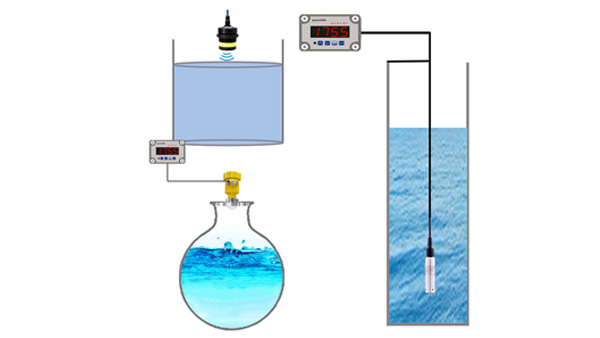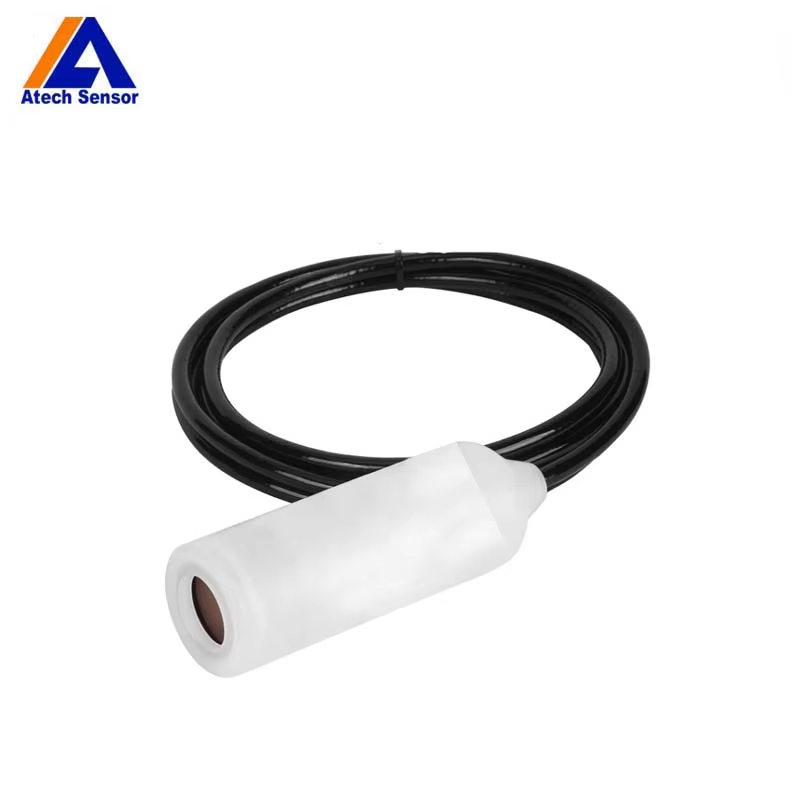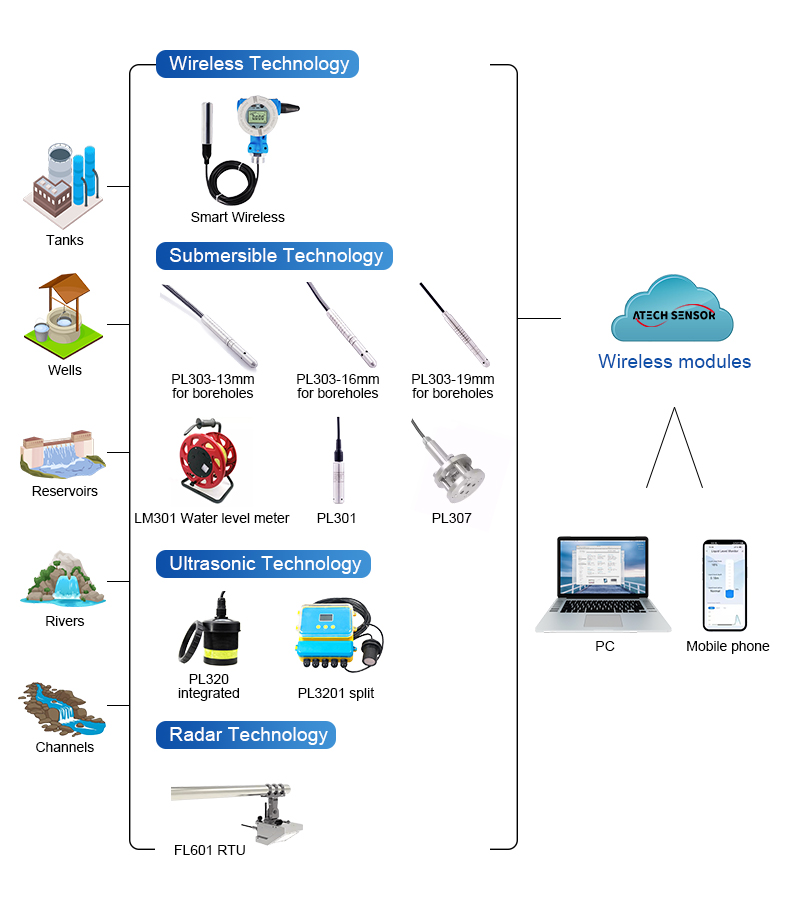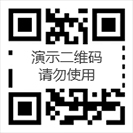Liquid Level Sensor (Hydrostatic Level Gauge/Level Transmitter/Level Sensor/Water Level Sensor) is a kind of pressure sensor to measure liquid level.Hydrostatic input level transmitter (level meter) is based on the principle that the static pressure of the measured liquid is proportional to the height of that liquid, and adopts isolated diffuse silicon sensitive element or ceramic capacitance pressure sensitive sensor, which converts the static pressure into an electrical signal, and then converts it into a standard electrical signal (generally 4-20mA/1-5VDC) after temperature compensation and linear correction, and is suitable for petrochemical industry, metallurgy, electric power, pharmacy,Water supply and drainage, environmental protection and other systems and industries of various media level measurement.
Products
Divided into two categories: a type of contact, including single-flange hydrostatic / double-flange differential level transmitter, float level transmitter, magnetic level transmitter, input level transmitter, electric float level transmitter, electric float level transmitter, capacitance level transmitter, magnetostrictive level transmitter, servo level transmitter and so on.The second category is non-contact, divided into ultrasonic level transmitter, radar level transmitter and so on.
Hydrostatic input level transmitter (level meter) is suitable for level measurement of various media in petrochemical, metallurgy, electric power, pharmaceutical, water supply and drainage, environmental protection and other systems and industries.Compact structure, simple adjustment and flexible installation for users to easily use the convenience of 4 ~ 20mA, 0 ~ 5v, 0 ~ 10mA and other standard signal output by the user according to the need to choose.Measuring liquid level using hydrostatic principle is an important application of pressure sensors.The use of special cables with ventilated conduits in the middle and specialized sealing technology ensures the watertightness of the sensor as well as the communication of the reference pressure chamber with the ambient pressure, thus guaranteeing high accuracy and stability of the measurement.

Typology
1、Float Level Sensor
Float level transmitter is to change the magnetic float to float, the level sensor is designed according to Archimedes buoyancy principle.Float level transmitter is the use of tiny metal membrane strain sensing technology to measure the liquid level, boundary level or density, it can work through the field button to set the routine operation.
2、Float Level Sensor
Float level transmitter consists of magnetic float, measuring conduit, signal unit, electronic unit, junction box and mounting components, the general specific gravity of the magnetic float is less than 0.5, can be floated above the liquid surface and along the measurement of up and down the conduit, the conduit is equipped with a measuring element, which can be measured under the action of the external magnetism will be measured under the level signal is converted into a proportional to the change in the level of resistance signals, and will be converted into 4 ~ 20mA or electronic unit.It can convert the measured level signal into a resistance signal proportional to the liquid level change under the action of external magnetism, and convert the electronic unit into 4~20mA or other standard signal output.
Level sensor for the modular circuit, with acid, moisture, shock, corrosion and other advantages, the circuit contains a constant-current feedback circuit and internal protection circuit, the maximum output current does not exceed 28mA, and thus can reliably protect the power supply and make the secondary instrumentation is not damaged.
3, Hydrostatic level sensor
The transmitter uses the measurement principle of static pressure of the liquid work, it is generally used in the silicon pressure sensor will be measured pressure is converted into an electrical signal, and then amplified by the amplifier circuit amplification and compensation circuit compensation, and finally to 4 ~ 20mA or 0 ~ 10mA current output.

Working Principle
Hydrostatic measurement principle: when the level transmitter is put into the measured liquid at a certain depth, the sensor facing the liquid surface is subjected to the pressure formula: Ρ = ρ .g.H + Po where:
P: the transmitter facing the liquid surface is subjected to the pressure
ρ: the density of the liquid to be measured
g: the acceleration of the local gravity
Po: the atmospheric pressure on the surface of the liquid
H: the depth of the transmitter put into the liquid
At the same time, the pressure of the liquid is introduced into the positive pressure chamber of the sensor through the air-conducting stainless steel, and then the atmospheric pressure Po on the liquid surface is connected to the negative pressure chamber of the sensor to counteract the Po on the back of the sensor.
so that the sensor measures the pressure as: ρ .g.H , and it is clear that the depth of the liquid level can be obtained by measuring the pressure, P .
Functional Features:
1. Good stability, fullness, zero long-term stability of up to 0.1%FS/year.In the compensation temperature range of 0 to 70 ℃, the temperature drift is less than 0.1%FS, and less than 0.3%FS in the whole allowable working temperature range.
2. With reverse protection and current limiting protection circuit, the transmitter will not be damaged if the positive and negative poles are reversed during installation, and the transmitter will automatically limit the current within 35MA when abnormal.
3. Solid state structure, no moving parts, high reliability, long service life.
4. Easy to install, simple structure, economical and durable.
Main Technical Parameters:
Process: Diffusion Silicon Ceramic Capacitor Sapphire Capacitor Optional.Split one-piece optional, Range: 0---0.5--200 meters, Output: 4--20mA (2-wire) Power supply: 7.5---36VDC Recommended 24VDCCBM-2100/CBM-2700 Input Hydrostatic Level Meter Reliable corrosion-resistant and with a ceramic measuring unit probe, used for water purification, wastewater and brine level measurement.GY500 inputSplit level transmitter adopts diffusion silicon piezoresistive core, 316 all stainless steel structure, the shell adopts isolation and explosion-proof design, the input level meter is mainly applicable to the level measurement and control of rivers, underground water level, reservoirs, water towers and containers.The circuit adopts signal isolation and amplification, cut-off frequency interference design (strong anti-interference ability, anti-lightning strike), over-voltage protection, current limitation protection, shock resistance, anti-corrosion and other designs].Main technical parameters: b] Measuring medium: water, oil and other liquids Pressure type: gauge pressure, absolute pressure (no requirement default gauge pressure)
b, range: 0 ~ 300m intermediate range optional Comprehensive accuracy: 0.1%FS Output Signal: 4 ~ 20mA (2-wire), 0 ~ 5V, 1 ~ 5V, 0 ~ 10V (3-wire) Supply Voltage: 12 ~ 36VDC Medium Temperature: -30 ~ 60 ℃ Ambient Temperature: -40 ~ 85 ℃ Zero Temperature Drift: ≤ ± 0.05% FS ℃ range temperature drift: ≤ ± 0.05% FS ℃ Compensation Temperature: 0 ~ 70 ℃ Safety Overload: 150% FS Limit Overload: 200% FS Sampling Frequency: ≤ 2ms Load Capacity: (Current Type) 250 ~ 1425% FS Sampling Frequency: ≤ 2ms Load Capacity: (Current Type) 250 ~ 1425% FS0.05%FS℃ Compensation Temperature: 0~70℃ Safety Overload: 150%FS Limit Overload: 200%FS Sampling Frequency: ≤2ms Load Capacity: (Current Type) 250~1425Ω (Voltage Type) ≥2KΩ Sealing Grade: IP68 Long-term Stability: 0.1%FS/year Vibration Impact: In the mechanical vibration frequency of 20Hz~1000Hz, the output change isLess than 0.1%FS Mechanical Connection (Threaded Interface): Drop-in (Submersible) Product Dimensions (mm): b]
Product ParametersMeasured medium: liquid (weak corrosive)
Pressure type: gauge pressure
Range: 0 ~ 0.1M ~ 1M ~ 3M ~ 5M ~ 10M ~ 20M ~ 50M ~ 100M ~ 200M ~ 500M (water level height / depth, the minimum range of 0.1 meters)
Output: 4 ~ 20mA (2-wire), 0 ~ 5VDC, 0 ~ 10VDC, 0.5 ~ 4.5VDC (3-wire)
Comprehensive Accuracy: ±0.25%FS, ±0.5%FS
Power Supply: 24V Dc (9~36VDC)
Insulation Resistance: ≥1000 MΩ/100VDC
Load Resistance: Current Output Type: Maximum 800Ω
Voltage Output Type: Greater than 50KΩ
Medium Temperature: -20~85℃
Ambient Temperature: -20~85℃
Storage Temperature: -40~90℃
Relative Humidity: 0~95% RH
Sealing Grade: IP68
Overload Capacity: 150%FS
Response Time: ≤5mS
Stability: ≤±0.15%FS/year
Vibration Impact: ≤±0.15%FS/year (Mechanical Vibration Frequency: 20Hz~1000Hz) Electrical Connection: 3/5 cores of air-conducting shielded cables are fully encapsulated; 8 meters of wiring is standard.
Pressure Connection: Input Type
Connection Thread Material: 304/316LStainless steel

Similarity and difference
Level switch is a kind of controller that opens the valve for discharging or feeding water according to the signal output from the liquid level sensor to keep the water level constant.It can also be said that the level switch output is a switching signal, the level switch first to determine the height of the liquid level, based on this height to output switching signals.And the level sensor is the height of the liquid level into the form of electrical signals for output.We can process the electrical signal, such as and plc, data collector or professional display connected to output the height of the liquid level.Another thing is that the principle of level switch and level sensor is the same.But the level switch is a switch control circuit, while the level sensor is equivalent to the voltage, variable current with the circuit components.
Photoelectric Liquid Sensor
Photoelectric level sensor is the use of light in two different media interface reflection refraction principle and the development of a new type of contact point level measurement and control devices.It has a simple structure, high positioning accuracy; no mechanical parts, no debugging; high sensitivity and corrosion resistance; low power consumption; small size and many other advantages by the market gradually recognized.
1, because the output of the liquid level is only related to the photoelectric probe whether to contact the liquid surface, and other characteristics of the medium, such as temperature, pressure, density, electricity and other parameters are not relevant, so the photoelectric level sensor detection is accurate, high repeatability; fast response speed, the liquid level control is very accurate, and do not need to be calibrated, you can be directly installed and used.
2, because the photoelectric level sensor probe volume is relatively small, can be installed separately in a small space suitable for special tanks or containers.In addition, you can also install multiple photoelectric sensors on a measuring body to make multi-point liquid level sensor, variable controller.
3, due to all the components inside the sensor for the resin casting treatment, the sensor does not have any mechanical moving parts, so the photoelectric level sensor is highly reliable, long life, maintenance-free.
Industry Status
At the beginning of the 21st century, the development of industrialization of liquid level sensors is still not a small challenge.It is reported that China has more than 1,700 companies engaged in the production and research and development of liquid level sensors, liquid level sensors annual output exceeded 2.4 billion, liquid level sensor products reach 10 categories, 42 subcategories, more than 6,000 varieties, showing a good development trend, but in this enterprise, foreign-funded enterprises have a clear advantage, the proportion of foreign-funded enterprises reached 67%, especially in Japan, the United States, South Korea and Germany.The proportion of state-owned enterprises and national enterprises is only 33%.Domestic and foreign enterprises have different comprehensive strength, small scale, shortage of talents, weak R&D capability, and it is difficult to compete with foreign enterprises.
More critically, technically, the domestic level sensor technology is weak, mainly the following three points:
First, the lack of core technology and basic capabilities, the core chip is heavily dependent on foreign imports, domestic enterprises in the high-precision, high sensitivity analysis, component analysis and special applications of the high-end aspects of the gap with foreign enterprises is obvious.
Second, in the design, reliability, packaging and other aspects, the lack of uniform standards and independent intellectual property rights, in the interface, deep etching, high-temperature ohmic contact, high-reliability MEMS packaging, rapid testing, high simulation simulation and other technologies have not yet made a breakthrough and industrialization verification;
Third, the product in terms of varieties, specifications, series and so on is not comprehensive enough in terms of measurement accuracy, temperature characteristics, response time, stability,Reliability and other technical indicators are still not a small difference, so China's float level meter sensor enterprises have a long way to go.
Development prospect
In recent years, the domestic magnetic flap level sensor market has been growing continuously at a rate of more than 10%, and in 2010 China's level sensor sales reached 90.5 billion yuan.It is predicted that the next five years China's liquid level sensor market will develop steadily and rapidly, under the impetus of the significant growth of the Internet of Things market size, in 2015 China's liquid level sensor market size is expected to reach more than 1.2 billion yuan.
According to statistics, by 2013, China's Internet of Things overall market size will reach 750 billion yuan, as the Internet of Things "pyramid" of the bottom layer and the most basic links, liquid level sensor industry will benefit directly from it.

